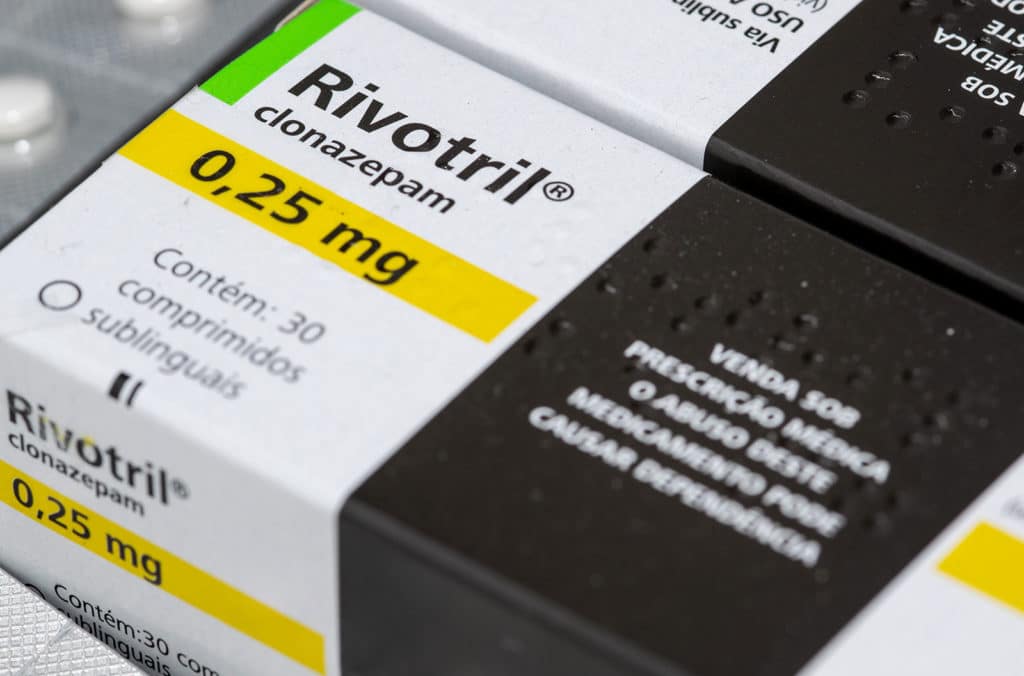Living with anxiety disorders or seizure conditions can be challenging, but medications like clonazepam can provide relief for many people.
While effective when used as prescribed, it’s important to understand how this medication works, its potential effects, and when its use might become an issue.
In this article, we explore clonazepam in detail. We offer insight for those taking it, concerned about loved ones, or seeking help for problematic use.
Table of Contents
What Is Clonazepam?
Clonazepam, commonly known by its brand name Klonopin, belongs to a class of medications called benzodiazepines or “benzos.”

First developed for treating epilepsy, this prescription medication works as a central nervous system depressant. It helps calm excessive electrical activity in the brain.
Fact: The FDA has classified clonazepam as a Schedule IV controlled substance, recognizing its therapeutic benefits while acknowledging its potential for dependence. As a prescription medication, it should only be used under the careful supervision of a healthcare provider.
Clonazepam is available in tablet form, either as a standard pill to be swallowed or as an orally disintegrating tablet that dissolves on the tongue. Additionally, Clonazepam comes in various strengths ranging from 0.125 mg to 2 mg.
The medication has a relatively long half-life compared to other benzodiazepines like Xanax (alprazolam). In other words, it stays active in the body for a longer period, typically between 18 to 50 hours. That’s why clonazepam is often prescribed for short-term use due to its habit-forming potential.
How Does Clonazepam Work?
Clonazepam functions by enhancing the effects of gamma-aminobutyric acid (GABA). The latter is a natural neurotransmitter in the brain that inhibits certain brain signals and decreases activity in the central nervous system.
By binding to specific GABA receptors, clonazepam increases the inhibitory effects of GABA. The process produces calming effects throughout the nervous system.
This mechanism explains why some people experience a “high” when taking clonazepam, especially at doses higher than prescribed. The sedative effects can create feelings of relaxation, reduced anxiety, and sometimes euphoria.
After taking clonazepam, it’s absorbed quickly into the bloodstream, with effects beginning within 20-60 minutes. While peak concentration occurs within 1-4 hours, the drug remains in the body much longer due to its extended half-life.
What Is Clonazepam Used For?
Healthcare providers prescribe clonazepam primarily for several specific health conditions:
- Seizure disorders: Including epilepsy, where the drug helps prevent and control certain types of seizures.
- Panic disorders: For people experiencing sudden and repeated attacks of fear, clonazepam can reduce the frequency of panic attacks and associated anxiety symptoms.
- Anxiety disorders: While not typically a first-line treatment for general anxiety, it may be prescribed short-term for severe anxiety when other treatments haven’t been effective.
- Certain movement disorders: Such as akathisia (restlessness) or restless legs syndrome.

What Are the Common Side Effects of Using Clonazepam?
Like all medications, clonazepam can cause side effects that range from mild and temporary to more serious and lasting. Understanding these potential effects is important for anyone taking this medication.
Note: Side effects can vary based on dosage, individual health factors, and duration of use.
Physical Side Effects
- Drowsiness and fatigue: The most common side effect, affecting up to 50% of people taking the medication
- Impaired coordination: Including dizziness, unsteady walking, and poor balance
- Slowed reaction time: This can make driving or operating machinery dangerous
- Muscle weakness: Feeling physically weak or experiencing reduced muscle tone
- Vision changes: Including blurred vision or double vision (diplopia)
- Speech difficulties: Such as slurred speech or trouble articulating words
- Respiratory effects: Slightly decreased breathing rate, particularly at higher doses
- Decreased heart rate: This medication can slow cardiovascular function
- Digestive issues: Including nausea, constipation, or changes in appetite
- Increased salivation, or conversely, dry mouth in some individuals
Psychological Side Effects
- Memory impairment, particularly affecting short-term memory
- Cognitive slowing, difficulty with concentration and thinking clearly
- Emotional changes, including mood swings, irritability, or emotional blunting
- Confusion, disorientation, or difficulty processing information
Long-Term Effects
- Tolerance: Needing increasingly higher doses to achieve the same therapeutic effect
- Physical dependence: Where the body adapts to the presence of the medication, leading to withdrawal symptoms if stopped abruptly
- Persistent sleep changes
- Reduced coping skills: Some individuals may become psychologically dependent on the medication to manage stress and anxiety
- Impaired learning: Difficulty acquiring new skills or information due to cognitive effects

What Does a Clonazepam High Look Like?
When someone uses clonazepam in ways not prescribed by a healthcare provider—such as taking higher doses, using it without a prescription, or combining it with other substances—they may experience what’s commonly referred to as a “high.”
Someone experiencing a clonazepam high typically shows several noticeable signs. The person may appear unusually drowsy, for instance, or have difficulty staying awake. Some users also report feelings of intense happiness that seem disconnected from circumstances.
Those abusing clonazepam experience slowed or slurred speech, impaired coordination, and reduced inhibitions as well. They’ll go through what’s known as a “zombie-like” state where they have a detached, vacant expression, and delayed responses to questions or stimuli.
Additionally, clonazepam abusers may engage in risk-taking behaviour or disconnect emotionally from others. They withdraw from family, friends, or activities they previously enjoyed.
As for physical signs of abuse, look for pinpoint pupils, flushed skin, and decreased blood pressure. The person may also display sudden mood changes, including irritability when the effects begin to wear off.
How Long Does a Clonazepam High Last?
The duration of a clonazepam high varies based on several factors, including dosage, individual metabolism, and whether it’s being used with other substances.
Generally, the intensified effects or “high” from clonazepam lasts between 1-4 hours, peaking around the 1-2 hour mark after ingestion.
That said, due to clonazepam’s long half-life, some effects may persist much longer. So, even after the initial intense feelings subside, residual effects like drowsiness and impaired coordination can continue for 12 hours or more.
How Much Clonazepam Does It Take to Get High?
The quick answer? No specific dose universally produces a “high,” as individual responses to clonazepam vary significantly based on the aforementioned factors.
For some individuals, particularly those without tolerance to benzos, even therapeutic doses (0.5-2mg) might produce euphoric feelings. Others with developed tolerance may take several times the prescribed amount seeking the same effect.
The method of consumption also affects how quickly and intensely the effects are felt. When taken orally as prescribed, clonazepam is absorbed more gradually.
However, some people misuse clonazepam by crushing and snorting the tablets. This delivers the drug more directly to the bloodstream through nasal tissues.
Recognizing overdose symptoms is critical as they can be life-threatening. Signs include:
- Extreme drowsiness progressing to unconsciousness
- Severe confusion or disorientation
- Bluish discolouration of lips or nails (cyanosis)
- Significantly slowed or troubled breathing
- Complete loss of coordination
- Unresponsiveness
- Weak pulse or dramatically lowered blood pressure
- Cardiac complications, including possible arrest

Taking Clonazepam with Other Drugs
Combining clonazepam with other substances—whether prescription medications, alcohol, or illicit drugs—can create dangerous and potentially life-threatening interactions.
Some of the most concerning combinations include:
Alcohol and Clonazepam
This combination dangerously enhances sedative effects. It dramatically increases the risk of respiratory depression, unconsciousness, and fatal overdose. Studies show that alcohol is involved in approximately 25% of benzodiazepine-related emergency room visits.
Opioids and Clonazepam
This combination has led to countless overdose deaths. Both drug classes suppress breathing, and together they can completely stop respiratory function.
Other benzodiazepines
Taking multiple types of benzos (like Xanax or Valium along with clonazepam) multiplies the risk of severe central nervous system depression.
Stimulants and Clonazepam
Some people use stimulants to balance Klonopin’s effects, but it places tremendous strain on the cardiovascular system and masks signs of potential overdose.

Seeking Treatment for Clonazepam Addiction
Recovery from clonazepam dependence is possible with proper support and treatment. If you’re concerned about your use of clonazepam, or that of a loved one, know that compassionate, effective help is available.
At Illinois Recovery Center, we understand the complexity of benzodiazepine dependence and offer comprehensive treatment programs. Our JCAHO-accredited facility provides a supportive environment where healing can begin.
Taking that first step toward recovery shows tremendous courage. Contact our admissions team today to speak with someone who understands what you’re going through and can help you find your path forward.



